Exclusive: Inside the making of new F1 movie with director Joseph Kosinski
‘It’s like Top Gun on wheels’ — why the F1 movie will leave fans breathless
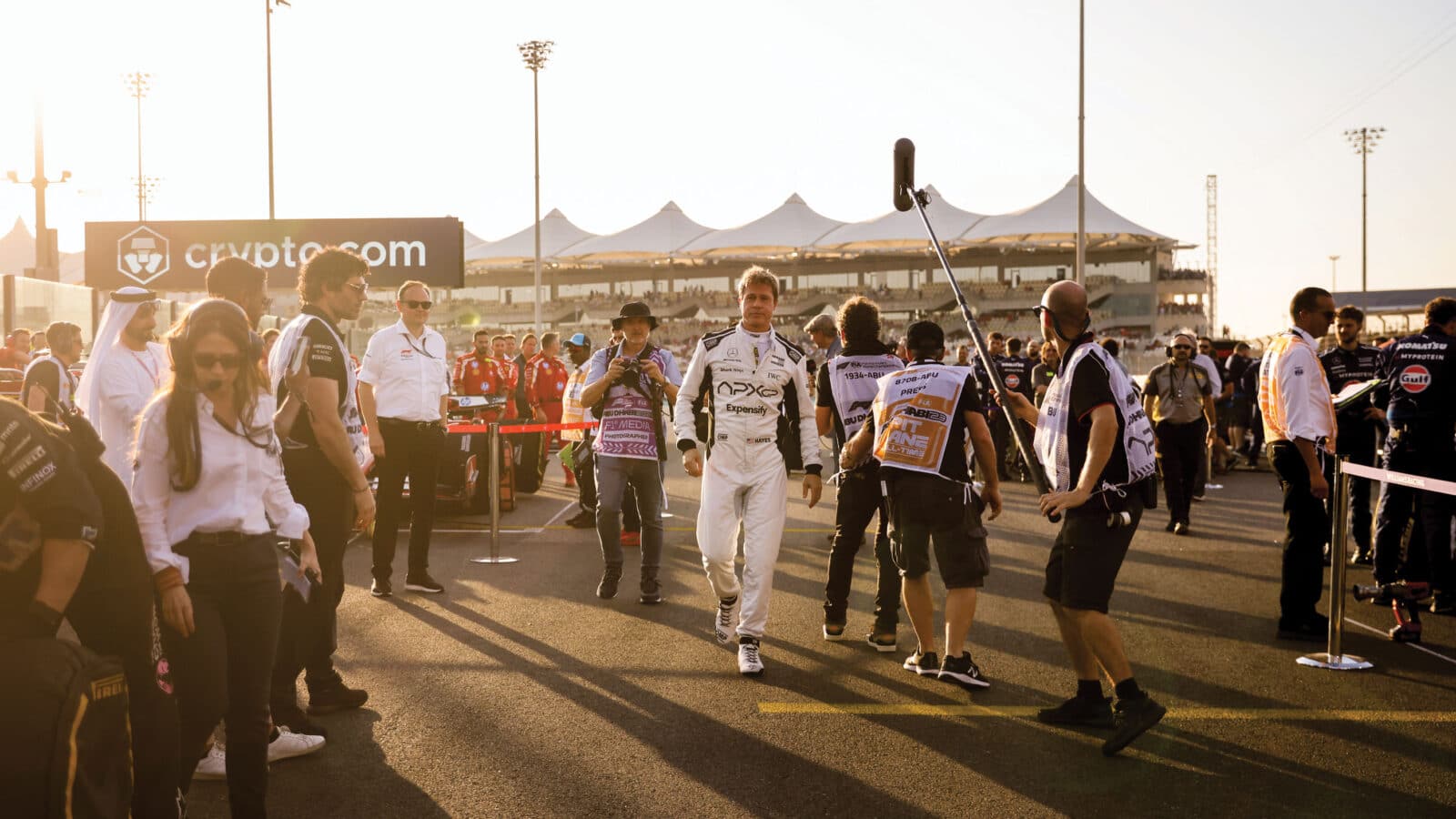
Getty Images
First F1 conquered the small screen with Drive to Survive. Now it is aiming to do the same with the silver screen with a star studded movie release. In production for well over two years the new film, set for release in the UK on July 25, is already being talked about as the summer’s big blockbuster.
With a budget rumoured to be around $300m and Brad Pitt in the lead role, there is speculation that it may eclipse even Ford v Ferrari, the surprise motor sport hit of six years ago and the film that brought Le Mans to the mainstream masses.
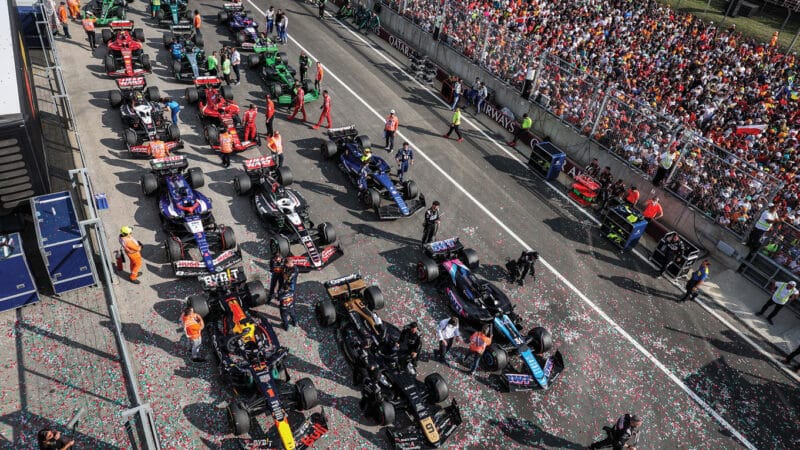
An Apex GP car, centre, front, mingles with real F1 racers at the 2024 Hungarian GP
DPPI
Details of the film’s plot are being kept under strictest secrecy. However, the bones of it are as follows: ageing racer Sonny Hayes (Pitt) was the best of his generation in his heyday during the 1990s until a horror crash ended his competitive career. The film picks up 30 years on when Hayes – “a nomadic racer-for-hire” – is approached by his former teammate Ruben Cervantes (Javier Bardem), owner of a struggling F1 team that is on the verge of collapse. Ruben convinces Hayes to have one last shot at saving the team and being the best in the world.
He is pitted against a cocky young hotshoe racer Joshua Pearce (Damson Idris), setting up a finale where, as the publicity has it: “In Formula 1 your teammate is your fiercest competition—and the road to redemption is not something you can travel alone”
So far so Hollywood of course. But what sets this film apart from previous attempts to dramatise the sport is the close cooperation between F1 and Apple Original Films, the makers, and the extraordinary lengths they went to to recreate the realism of racing. From filming live at grands prix through 2023 and 2024 to involving all 10 teams and their drivers who appear in the film as themselves.
Formula 1 has been asked to cooperate with Hollywood before. Twenty six years ago Sylvester Stallone made multiple visits to the paddock for his film Driven, released in 2001, but the tie-up didn’t quite happen. If you’ve watched Driven, eventually based on Champ Car instead, you might say F1 dodged a bullet. But that scenario could easily have made the sport wary of letting anyone have the keys to circuits to try and create a movie based on the series.
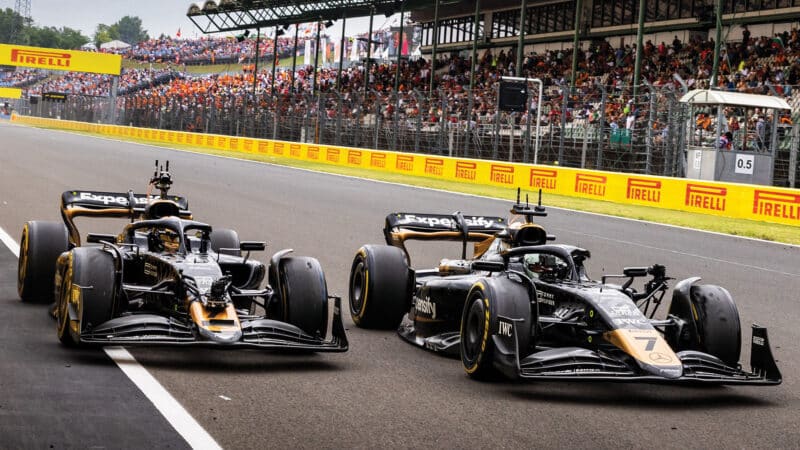
Film cars are actually F2s
DPPI
F1 director of media rights Ian Holmes was just starting out when Bernie Ecclestone was showing Stallone around. But in the two decades since then, he has seen first-hand a change in mindset around the sport, and when the Joseph Kosinski-directed idea of an F1 film came across his desk – initially through Lewis Hamilton’s then-manager Penni Thow – it soon became clear what a potentially huge project was being proposed.
“I think the people [convinced us],” Holmes says. “And we shouldn’t ignore Apple. It’s a big company, they don’t do things by halves, top of the level… It quickly became apparent that this is a very serious, very big opportunity, which remarkably removes any scepticism. The contractual process was quite convoluted and complicated, but it’s a big old project with a lot of investment taking place and everyone had their positions to protect.
“But I think while we hadn’t really done anything like it, it was obvious very quickly that this was a big deal and needed to be taken seriously and done right. And it certainly has been.”
Thow’s introduction came after Kosinski had already been in touch with Hamilton about wanting to make a racing movie, with the seven-time world champion his starting point when it came to aiming for authenticity. Hamilton put Kosinski – the Top Gun: Maverick director – in front of Mercedes, and momentum built.
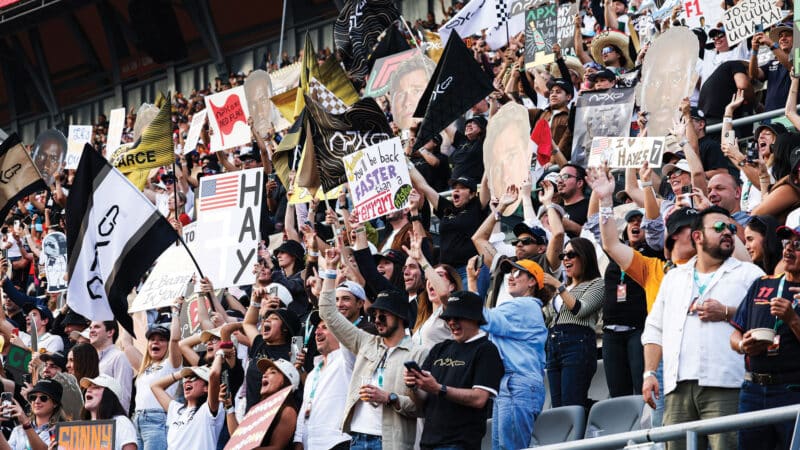
Who are you calling plastic supporters? The Apex fans make their presence felt at last year’s Mexican GP
DPPI
“I started talking with them about wanting to capture the speed of this sport,” Kosinski recalls. “And it was actually Toto [Wolff] who came up with the idea of rather than making a movie car that was fast enough to achieve these speeds, he said why don’t you start with a race car – a real race car – and then work the cameras that you need into that?”
An actual F1 car was soon ruled out on the grounds that it is so complex, differs depending on the constructor, and no team was likely to have the capacity to build multiple versions. Not to mention the cost. So attention turned to a Formula 2 car, where a spec Dallara chassis could provide the platform to add cameras and F1-style bodywork, all while being slightly more driver-friendly for the actors and avoiding any intellectual property concerns between rival F1 teams. But it still needed plenty of research and development to ensure the movie car could operate at high speeds.
Mercedes Applied Science helped with the design, which was far from a simple process, but Kosinski wanted lead actors Brad Pitt and Damson Idris to physically drive the racing cars at full speed as much as possible.
“Early on we understood that with the proportions, we couldn’t make an F2-size car look like an F1 car unless we changed the wheelbase,” Mercedes composite design engineer Juan Villalba explains. “So we had to change the wheelbase. That was a bit of a nervous moment to see how we can actually do this and make it robust, but we found a way [with a spacer].
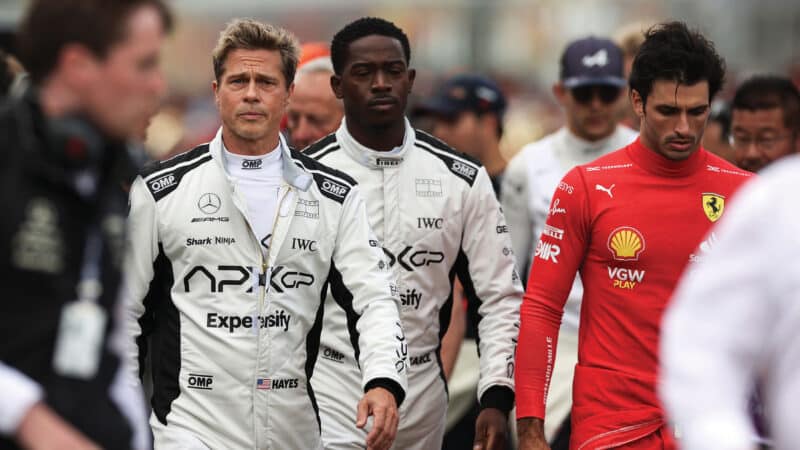
Sonny Hayes (Brad Pitt) and team-mate Noah Pearce (Damson Idris) walk the walk with real F1 heroes at Silverstone
Getty Images
“Also I think the front wing was one scary moment as well, because we didn’t have time to get a nose, so we had to make something work with an existing [F2] nose, and that was challenging. Remember these are not show cars, they were cars that were to be driven at pretty much the same speed as the F1s. As you can probably imagine, the wings on the cars, when they go at speed on the straights, the aero loads were huge. It was a lot of work to make sure that the front wing, for example, was able to live with an existing nose. All these sort of problems were coming up all the time.
“We changed the floor, we probably generated too much load, and we didn’t want to overwhelm the car itself, because the car is being designed for different loads.

Director Kosinski brought some of his techniques from 2022’s Top Gun: Maverick to use in F1
Courtesy Warner Bros. Pictures
“We wanted to make a car that looked fast… but not too fast, stable… So it was a bit of a strange scenario to be in, but it was mainly just so you can have a car that can visually look like an F1, but still can be driven at speed.”
“Six cars in total were produced and proved to be capable of strong pace”
Six cars in total were produced – through a combination of Mercedes and movie specialists – and proved to be perfectly capable of lapping at a strong pace, all while carrying camera equipment that would allow Kosinski to capture multiple angles of the drivers at work behind the wheel, both up close within the cockpit and also the surrounding environment of the circuit.
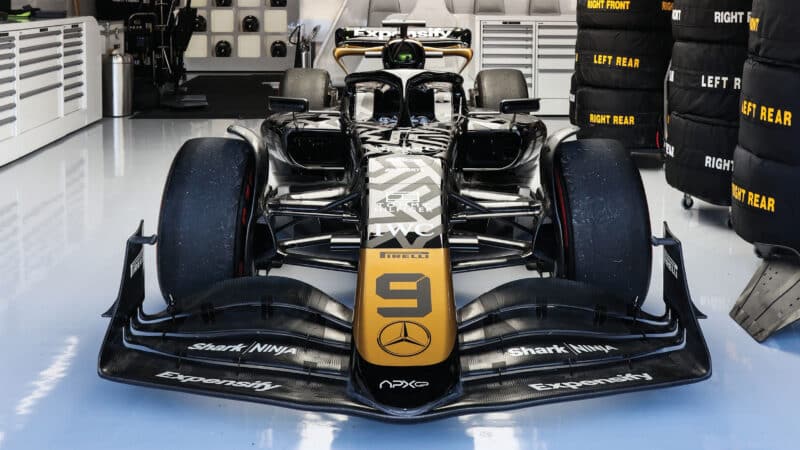
Mercedes Applied Science modified the F2 car to make it look like an F1 racer; note the Mercedes branding
DPPI
“We had to develop a brand new camera system, taking everything we learned on Top Gun: Maverick and pushing it much further,” Kosinski says. “You know, you can’t put 60lb of gear onto a race car and expect it’s going to perform the same way. So we took those Top Gun cameras and we worked closely with Sony sizing them down to something about a quarter of the size.”
With high-performance machinery in place, the actors themselves also had to be able to hustle the cars just as any professional driver would. To try and truly portray the violence of driving a single-seater at close to Formula 1 level, Kosinski needed Pitt and Idris behind the wheel to capture legitimate reactions, so the pair went through intensive training at the Winfield Racing School at Paul Ricard, along with other locations, under the tutelage of stunt drivers Luciano Bacheta, Craig Dolby and Duncan Tappy.
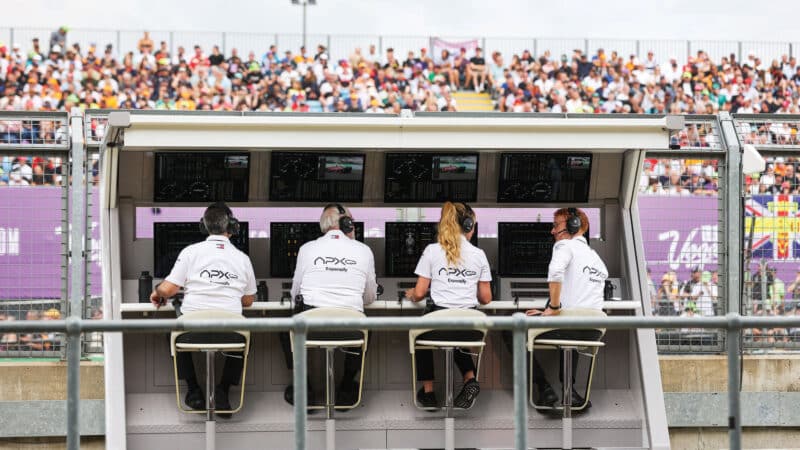
“If only we could reach Mark Hughes” – the Apex pitwall.
DPPI
“A stellar cast and crew needed to be in the F1 paddock at weekends”
But even with the actors developing their driving skills, and the technical ability to capture everything required, a stellar cast and crew still needed to be incorporated into the F1 paddock at race weekends in order to film.
A project lead from F1’s side was identified and installed in the form of former McLaren director of communications Tim Bampton to help facilitate all of the discussions that would be required with the production team.
“We know an awful lot more now than we knew [when we started],” Holmes says. “I quickly realised that I wasn’t going to be able to co-ordinate things, but only now knowing how far off the mark I was in terms of ‘no way!’ We were looking for someone to be the point person of all things Formula 1. And it wasn’t my bright idea but that’s how Tim came to be. I sat down with Tim and we both agreed it was a good idea. I think even Tim didn’t know quite what he was getting into. He now looks like a proper producer. He knows all the terminology and everything!
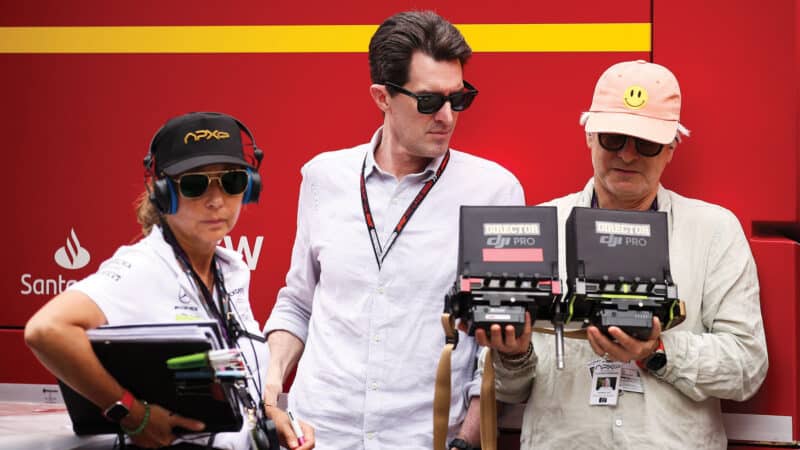
F1 director Joseph Kosinski, left, and cinema-tographer Claudio Miranda
DPPI
“But appointing Tim was essential, because it mushroomed into a phenomenally big operation. To have someone like that who’s got so many contacts across the sport – teams, us, various other entities – bringing Tim in, I think, from an operational point of view, was super-important.”
Bampton’s role was extremely wide-ranging. To deal with so many different stakeholders was a major challenge, particularly when it came to filming at tracks. Certain elements were relatively simple, as existing broadcast contracts meant ticket holders already accept they could be part of filming at a live event when they attend a grand prix. Even though the film-makers would make it clear they were capturing footage for the movie, no additional agreements were required on that front.
To be allowed to film in a pitlane or on the grid at various races, however, was a different matter entirely, and this took plenty of collaboration.
“The promoters were absolute partners in this movie,” Bampton explains. “We marshalled and facilitated that with the promoters, and obviously the relationship with the promoters is F1’s relationship, and those are incredibly important relationships for us. So we wanted to make sure they were comfortable, but all the promoters understood the benefit of it.
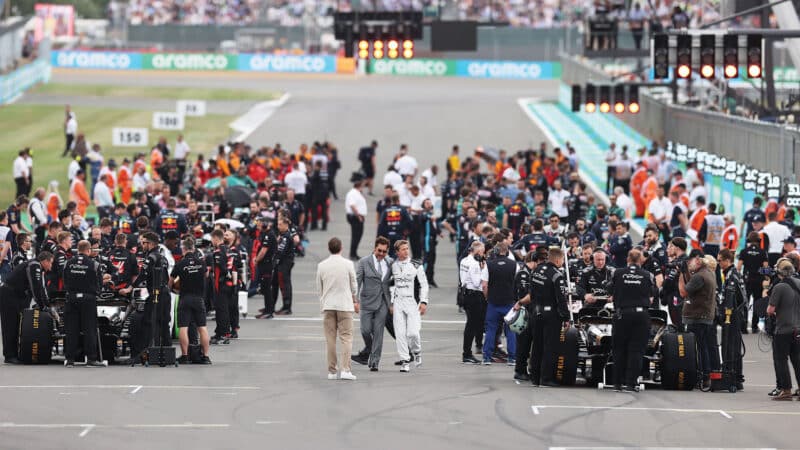
Principal photography started at the 2023 British GP – Pitt is joined by Javier Bardem who plays the Apex owner
Getty Images
“We worked as a kind of triangle of the movie production, Formula 1 and the promoter. We took the time up front to explain the vision and what they were looking to achieve, and enable the locations team to work with our circuit engineering team and our race operations team, and the various constituent elements of the Formula 1 operation itself, and the promoter – of course, there’s a great relationship there already – so that moved the path quite a lot.
“But the promoters were absolutely important stakeholders. I mean, of course, once we came to anything to do with on-track action or operating within the paddock, it was in our hands, but we kept the promoters very close to what was going on in general, and they were all massively supportive.”
The FIA also needed to be involved to provide clearance for track running, with the production operating to military precision in order to get the required shots within far smaller windows than would usually be the norm on a closed set.
“It was like a live stage play in front of hundreds of thousands”
“It was a very unique way of working,” Kosinski admits. “Rather than having a whole day to shoot a scene like you normally would on a movie, we had these nine or 10-minute slots. So it was like a live stage play, but in front of hundreds of thousands of spectators, while shooting at 180mph, literally.”
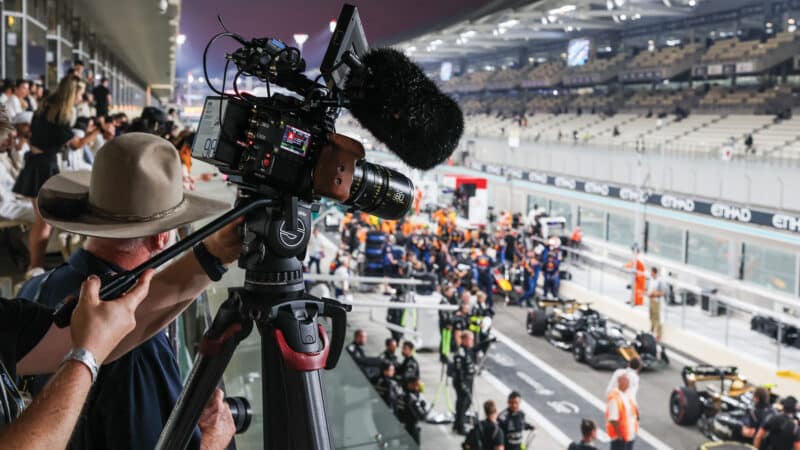
Filming locations included Silverstone, the Hungaroring, Spa, Suzuka and here at the Yas Marina circuit in Abu Dhabi
DPPI
Scenes ranged from on the grid at certain races, to parc fermé and podium shots, all of which would either run the risk of interfering with a grand prix start or the post-race procedures. Bampton sees the first such weekend at Silverstone in 2023 as “critical” to earning the trust of the paddock that the film could be executed without disruption, even if things didn’t go entirely to plan.
Both film cars were due to pull away with the rest of the grid on the formation lap, but F1 and the FIA could not afford for any delays if they failed to do so.
“The request from [the production team] was to have the cars on the grid and then we had to look at how to make that work,” F1’s circuit operations and logistics head James Boughton says. “We had discussions with the FIA because it’s very much in their world, they’re responsible for the Formula 1 track activity and safety, so we’re crossing into their territory at that point and we had to get clearance for them to do what they wanted to do.
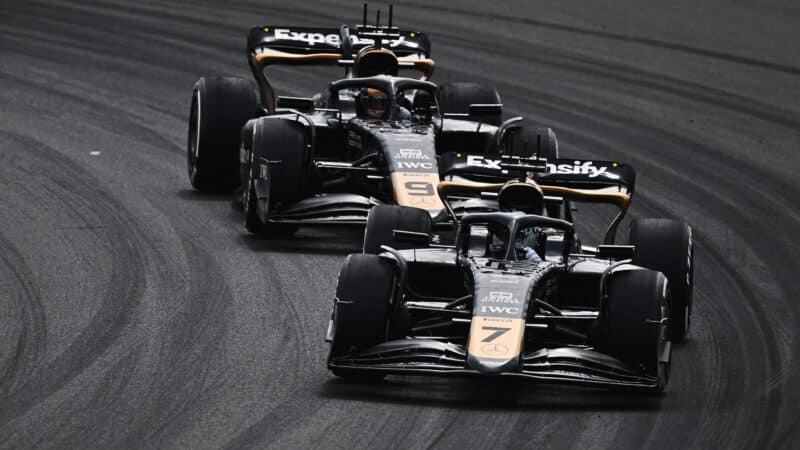
It’s been 47 years since an American last won an F1 world title… perhaps this is the only way they’ll get the crown
Getty Images
“They were never comfortable with the idea of the two cars pulling away at the back, but when we explained the reasoning behind it they said, ‘OK,’ and we said, ‘We have a back-up plan if it doesn’t work – we go through the crash gate.’”
“Real racing drivers were involved, adding to the authenticity”
With Silverstone successfully handled, the Formula 1 teams and the FIA were then more open to each future request and the production could film during a number of race weekends from that point on. That allowed the real racing drivers to be involved on many occasions, adding to the authenticity of the fictional team being a part of the paddock.
Kosinski reveals that having that level of buy-in from the sport itself was one of the highlights of the entire movie project, and allowed him to achieve his goal of directing the most realistic Formula 1 film he possibly could.
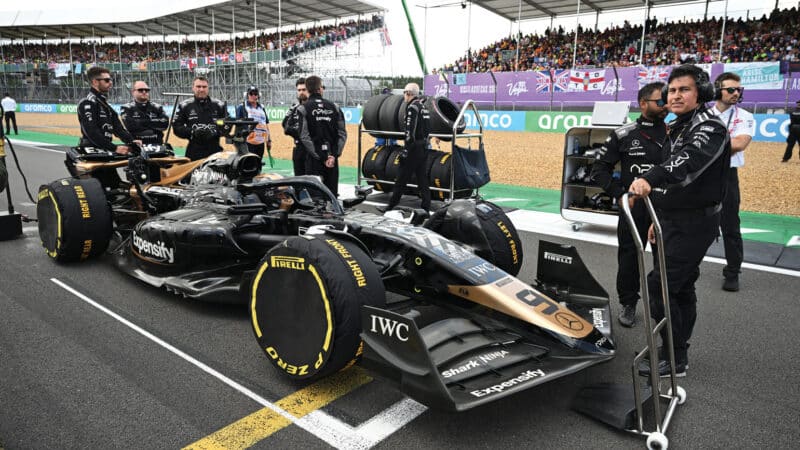
The film will be released in the UK on June 25 – a few days before the Austrian Grand Prix
Getty Images
“Working alongside Lewis and all the other drivers on the grid, and having them embrace us – asking to be part of that family in that world… And to say you’re making a movie, there’s going to be some reticence there,” Kosinski admits.
“But when they saw how determined we were to make it authentic and represent their sport in the absolute best way we could, to have them accept us and to be able to have them play themselves in the film, to be able to shoot on the track alongside them, showed a level of trust that was really remarkable. There’s just no way this film would exist without that.”
Certainly the drivers appear happy with the result which was shown to them at the Monaco GP. All apart from Max Verstappen who skipped the screening. “I’ll download it on Apple,” said the world champion, perhaps not exactly sticking to the script.
